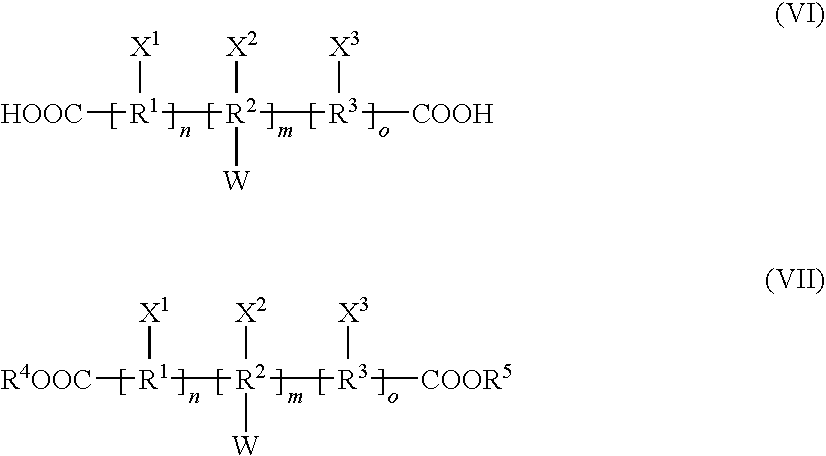Process for the preparation of polycarbonate by the melt transesterification method
- Summary
- Abstract
- Description
- Claims
- Application Information
AI Technical Summary
Problems solved by technology
Method used
Image
Examples
example 1
Comparative Example
[0203]7500 kg / h of melt mixture comprising 3741 kg / h of diphenyl carbonate (17.45 kmol / h) and 3759 kg / h of bisphenol A (16.47 kmol / h) were pumped from a receiver, with addition of 4.19 kg / h of a catalyst mixture, through a heat exchanger, heated to 190° C. and fed through a dwell column at 12 bar and 190° C. The average residence time was 50 minutes. The catalyst mixture consisted of 0.52 kg of the phenol adduct of tetraphenylphosphonium phenolate (containing 65.5% by weight of tetraphenylphosphonium phenolate 0.786 mol) dissolved in 4.5 kg of phenol.[0204]The melt was then passed via an expansion valve into a separator under a pressure of 200 mbar. The melt flowing away was heated again to 200° C. in a falling-film evaporator likewise under 200 mbar and was collected in a receiver. After a residence time of 20 minutes, the melt was pumped into the next three, similarly designed stages. The conditions of pressure, temperature and residence time in the 2nd / 3rd / 4th ...
examples 2-18
Comparative Examples
[0210]The procedure was as in Example 1, except that, after the last basket reactor, i.e. the last process step, various aromatic and aliphatic carboxylic acids were added to the material. Spinning and granulation were then effected.[0211]The production of the discs and the measurement of the electric field strength were effected as described above.[0212]The aromatic and aliphatic carboxylic acids added in each case, amounts added and the results of the electric field strength measurement and of the phenolic OH content as well as the intrinsic viscosity are shown in Tab. 1.
example 19
Comparative Example
[0213]Commercially available polycarbonate prepared by the melt transesterification method from General Electric (Lexan® OQ1025) was used. The production of the discs and the measurement of the electric field strength were effected as described above. The results are shown in Tab. 1.
PUM
| Property | Measurement | Unit |
|---|---|---|
| Fraction | aaaaa | aaaaa |
| Fraction | aaaaa | aaaaa |
| Electric field strength | aaaaa | aaaaa |
Abstract
Description
Claims
Application Information
 Login to View More
Login to View More - R&D
- Intellectual Property
- Life Sciences
- Materials
- Tech Scout
- Unparalleled Data Quality
- Higher Quality Content
- 60% Fewer Hallucinations
Browse by: Latest US Patents, China's latest patents, Technical Efficacy Thesaurus, Application Domain, Technology Topic, Popular Technical Reports.
© 2025 PatSnap. All rights reserved.Legal|Privacy policy|Modern Slavery Act Transparency Statement|Sitemap|About US| Contact US: help@patsnap.com



